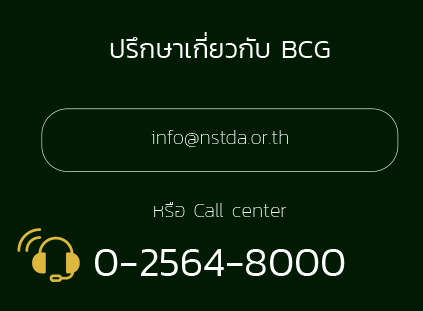
1.1 Background
Bio-Circular-Green Economy (BCG) model was introduced by the Thai Government as a strategy for the national development and post-pandemic recovery (The Secretariat of the Cabinet, 2021). BCG model places emphasis on applying science, technology and innovation to turn Thailand’s comparative advantage in biological and cultural diversity into competitive advantage, focusing on four strategic sectors, namely 1) agriculture and food, 2) wellness and medicine, 3) energy, materials and biochemicals, and 4) tourism and creative economy. It aims to promote sustainability of biological resources, strengthen communities and grassroots economy, enhance sustainable competitiveness of Thai BCG industries, and build resilience to global changes (Ministry of Higher Education, Science, Research and Innovation (MHESI), 2021). The model is expected to create sustainability and inclusiveness to Thailand’s economy, society and the environment.
Introduction
Thailand was among the United Nations Member States that adopted the 2030 Agenda for Sustainable Development. Since then, the country has been committed to the UN Sustainable Development Goals (SDGs) with some progress and success. In 2020, Thailand was ranked 43rd among 165 countries in SDG Index, a leap from the 55th place in 2017 (Jeffrey D. Sachs, Christian Kroll, Guillaume Lafortune, Grayson Fuller, and Finn Woelm, 2021). While the country has already achieved the target of SDG 1 which is to end the poverty, it is still faced with great challenges with SDG 2 (zero hunger), SDG 3 (good health and well-being), SDG 10 (reduced inequality), SDG 14 (life below water) and SDG 15 (life on land). It is expected that the Bio-Circular-Green Economy (BCG) model, introduced by the Thai Government as a strategy for the national development and post-pandemic recovery, will expedite Thailand to move closer and achieve most, if not all, SDGs in the post-COVID era.
Economic Transformation with BCG Model
Thailand’s post-COVID sustainable development strategy emphasizes the exploitation of knowledge, technology and innovation to create economic value to its strength and potential in natural resource wealth, cultural diversity and nurturing spirit. BCG model has been introduced to enable sustainable and inclusive growth, in line with the UN Sustainable Development Goals (SDGs) and the Sufficiency Economy Philosophy (SEP) (MHESI, 2021). The model aims at applying the concepts of bioeconomy, circular economy and green economy to develop high value products and services that are eco-friendly and require less resource input, while conserving natural and biological resources.
Turning Challenges into Opportunities
Thailand possesses multiple strengths in terms of food, public health and richness of natural resources and culture, and yet endures several challenges. The country earned 1 trillion THB (33 billion USD) from exporting food products in 2019 with the status of world’s top producer of rice, cassava and sugar. Despite high food volume production, 80% of the products are minimally processed, and therefore sold at low prices. While the country’s medical and wellness sector performs remarkably well, except during the pandemic, 70% of medicines used in the country are imported. In 2019, Thailand’s tourism revenue was 3 trillion THB (100 billion USD), placed 4th in the world, with 40 million international tourists. However, the revenue is mainly concentrated in 8 provinces and majority of the travelers are low budget tourists (MHESI, 2021).
Despite all challenges, there are opportunities for Thailand to thrive. As the world is embracing the idea of balanced and sustainable development, Thailand can promote the production of eco-friendly goods and services to fulfil this significantly expanding market. Consumers nowadays look for quality and safe products and services that meet international standards. Thai food products, especially ready-to-eat meals, are expected to be in high demand in the post-pandemic future, as the country is well recognized for its food quality and safety. New lifestyle leads to market opportunity in health products and services, on which Thailand can capitalize based on its wealth of herbal plants and traditional wisdom.
In view of the strengths, weaknesses and challenges, Thailand can certainly enhance its global competitiveness in the following areas:
- Hygienic Kitchen of the World. According to the United Nations, the world’s population is expected to increase from 7.6 billion in 2016 to 9.8 billion in 2050, driven by growth in developing countries. With this projection, demand for food will increase by 70%. Thailand, therefore, should take this opportunity to strengthen its food quality and safety standards to fulfil this growing market.
- High Value-added Products from Innovation and Creativity. Thailand is blessed with abundant farm products which can be grown all year round, as well as a large amount of under-utilized agricultural waste and by-product. This biomass can be converted to a wide variety of products. Biobased product market is expected to reach 350 billion USD in 2027 (Grandview Research, 2020), whereas that of biochemicals is projected to increase from 6.5 billion USD in 2016 to 24 billion USD in 2025.
- Healthy People. The Office of the National Economics and Social Development Council predicted that Thailand would become a fully aged society in 2021 and the elderly would make up one-third of the population by 2040. It is therefore imperative that Thailand develop self-reliance in healthcare.
- Happy Destination. The next chapter of Thailand’s tourism industry will shift towards quality tourism. A new form of tourism will be developed to ensure safety and sustainability, offering fair income distribution to locals and elevating tourist’s experience with medical and wellness tourism, as well as culinary tourism.
- Harmonious and Sustainable Society. The development will focus on creating fair wealth distribution to each and every sector and promoting conservation, rehabilitation and sustainable utilization of resources (MHESI, 2021).


